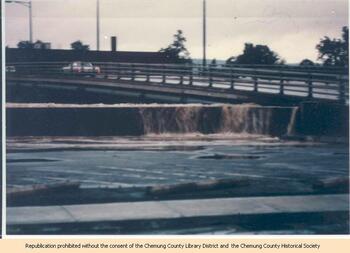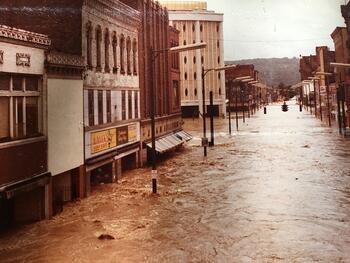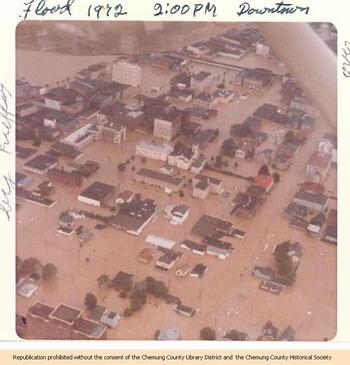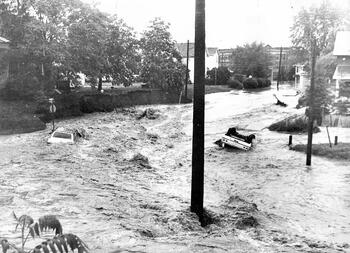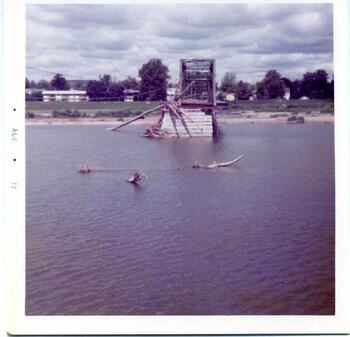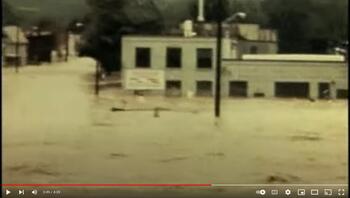East of Corning, the Chemung River runs directly through downtown Elmira. Founded in the early 1800s, Elmira’s central location in the state made it a hub of transportation and industry. Canals and railroads passed through Elmira, and by the turn of the 19th Century, it had become a waypoint connecting commercial centers in Rochester and Buffalo with Albany and New York City.
During the Civil War, the railroad junction also made Elmira a military depot, a draft rendezvous, and a notorious prisoner of war camp for captured Confederate soldiers. In the later part of the century, Mark Twain spent summers in Elmira with his wife's family, and is buried in the city’s Woodlawn Cemetery.
In the 20th Century, Elmira became a seat of manufacturing and retail. In 1935, Elmira Industries was formed, with the intention of drawing more industry to the area. Among its earliest successes was the Remington Rand typewriter corporation, a major employer. During World War II, a reported 90% of the population was involved in manufacturing, staffing 92 different factories and filling $80 million in war contracts (equivalent to $2.5 billion in 2022).
By the 1970s, national economic trends began to hurt Elmira. Many of its large employers closed their factories or relocated, looking for cheaper production costs.
The flooding on June 23, 1972, dealt the local economy a blow from which it never truly recovered. The river rose, washed out bridges and cut the city in half. Huge portions of the city were heavily damaged, particularly the businesses on Water Street. Most of these buildings were torn down after the flood and were never rebuilt.
Flood waters over the dike Lake & Water Streets at 5:30am [1972]. Courtesy of the Steele Memorial Library and Chemung County Historical Society.
This photo, taken at 5:30 am on June 23, shows the flood water beginning to spill over the concrete barriers designed to prevent just such an occurrence. This was the beginning of the flooding in Elmira.
Downtown Elmira during Flood of 1972. Courtesy of Timothy Wade, Sr. and Timothy Wade, Jr. (Maxq32) on Wikimedia Commons.
This photo was taken from the Erie-Lackawanna Railroad tracks looking down Water Street on the day of the flood. The storefronts that occupied the first floor of many of these buildings were subject to severe damage, as was any merchandise inside.
Downtown Elmira view from a helicopter [1972]. Courtesy of the Steele Memorial Library and Chemung County Historical Society.
An aerial view showing the extent of the flooding. All of downtown Elmira was underwater.
Flood Waters Raging Through a Residential Neighborhood. Courtesy of the Chemung County Historical Society and the Syracuse Post Standard.
This photo of a residential neighborhood in Elmira shows just how fast and destructive the flooding was.
View from the northern end of the Erie-Lackawanna railroad bridge crossing the Chemung River during the Flood of 1972. Courtesy of Timothy Wade, Sr. and Timothy Wade, Jr. (Maxq32) on Wikimedia Commons.
The fast-moving water carried away uncalculated amounts of wreckage and debris. Here it can be seen piling up against the Erie-Lackawanna bridge.
Walnut Street bridge destroyed [1972]. Courtesy of the Steele Memorial Library and Chemung County Historical Society.
Part of the Walnut Street Bridge collapsed under the strain of wreckage and debris washed against it with the powerful floodwater. It was deemed a loss and has been replaced by a wholly new structure.
"It Sprinkled, It Rained, and It Poured" by John Nickerson, Marina Nickerson, Ron Tesnow, and Cathy Tesnow. Courtesy of the Chemung County Historical Society on YouTube.
Four Elmirans were hanging out after a day of cleaning flood debris in July of 1972 when they casually wrote this song. The song was played at the local radio station, WELM, and copies were made by a press in Utica. Profits were donated to the Elmira Star-Gazette's Lend-a-Hand Fund for flood relief.
